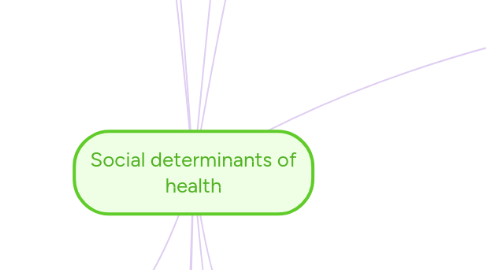
1. Health and opportunities
1.1. Country of birth significantly impacts your life course.
1.2. Although indigenous Australians are born into a wealthy country they have a life expectancy much lower than of non-indigenous Australians
1.3. Although HIV patients are now living longer than ever before their quality of life can be reduced due to the multiple drugs you are required to take, their side affects and mental health issues.
2. Ideas
2.1. Idea 1
2.2. Idea 2
2.3. Idea 3
3. HIV AIDS: a social justice issue (week 8):
3.1. health inequalities
3.1.1. Differences in:
3.1.1.1. access to health services
3.1.1.2. susceptibility to infectious disease
3.1.1.3. mortalitty
3.1.1.4. work-related injury rates
3.1.1.5. morbidity
3.1.2. causes:
3.1.2.1. gender factors
3.1.2.2. gender
3.1.2.3. health behaviors
3.1.2.4. exposure to toxins
3.1.2.5. access to health services
3.1.2.6. education disparities
3.1.2.7. income disparities
3.1.2.8. ethnicity
3.1.2.9. nutrition
3.1.2.10. housing
3.1.2.11. location/environment
3.1.2.12. unfair trade
3.1.2.13. globalisation
3.1.2.14. lack of autonomy
3.2. theories on justice
3.2.1. arrangement focused
3.2.2. relisation focused
3.3. social exclusions
3.3.1. Bristol social exclusion matrix
3.3.1.1. QUALITY OF LIFE:
3.3.1.1.1. health and wellbeing
3.3.1.1.2. living environment
3.3.1.1.3. crime, harm and criminalisation
3.3.1.2. resources
3.3.1.2.1. material, economic resources
3.3.1.2.2. access to public and private services
3.3.1.2.3. social resources
3.3.1.3. participation
3.3.1.3.1. economic participation
3.3.1.3.2. culture, education, skills
3.3.1.3.3. social participation
3.3.1.3.4. political and civic participation
3.4. Ottowa charter, in promoting health we must:
3.4.1. enable, mediate, advocate for health
3.4.2. create supportive environments
3.4.3. develop personal skills
3.4.4. reorient health services
3.5. professional practice, for a just practice:
3.5.1. responsible agent of society
3.5.2. treat, but also refer and advocate
3.5.3. build partnerships with client
4. Inequalities and structural determinants
4.1. Inequalities:
4.1.1. big improvements have been made to reduce inequalities
4.1.2. benefits have not been evenly shared globally
4.2. populations most vulnerable
4.2.1. poverty stricken areas
4.2.2. discriminated communities
4.2.3. populations working in unsafe environments
4.3. structural determinants:
4.3.1. Health service factors:
4.3.1.1. innefective health systems
4.3.1.2. under investment in health care infrastructure
4.3.1.3. inefficient use of health care funding
4.3.1.4. research and development not focused on poorer countries
4.3.1.5. shortage in health care professionals
4.3.2. Global economic and political factors
4.3.2.1. unequal distribution of money and power
4.3.2.2. thirdworld debt
4.3.2.3. globalisation
4.3.2.4. power of transnational corporations
5. Week 9 economic impact of disease (Macro and Micro)
5.1. GP co-payment would widen the health gap between indigenous and non-indigenous
5.2. More people would present to emergency department
5.3. Indigenous Australians are already under using system and this will increase with copayment
6. Language culture and health
6.1. When bodies breakdown. We look for language of pain relief
6.2. Waves of illness raise and drop over time according to how they are portrayed in media
6.3. Cultural competency is important because it can cause distress for patients and legal problems for health practitioners.
7. Social determinants on a global scale
7.1. Problem 1
7.2. Problem 2
7.3. Problem 3
8. health as a social construct
8.1. class gradient:
8.1.1. the higher social class, the greater the life expectancy
8.2. epidemiology:
8.2.1. incidence, distribution and possible control of diseases
8.3. language of human disorders
8.3.1. disease- malfunctions of the physiological and biological organisms
8.3.2. illness- individuals subjective awareness
8.3.3. sickness- designates appropriate social roles
9. Health and the media:
9.1. media:- plural of medium. the means of communication as radio, tv, newspaper, magazines. all reach large audiences
9.2. Agenda setting theory-
9.2.1. developed by McCombs and Shaw (1972)
9.2.2. determines whether an issue emerges as a social problem
9.3. framing
9.3.1. technique for telling us how to think about an issue
9.3.2. the presentation of a particular perspective of an issue to elicit a desired response
9.3.3. frames are reflected in the langauge and meanings applied to an issue
9.3.4. framing provides a technique for reinforcing norms and values
9.4. framing 2 types:
9.4.1. Episodic framing attributes individual responsivility
9.4.2. thematic framing attributes societal responsibility
10. Social determinants and the health care system
10.1. Health care systems:
10.1.1. protect people from social disadvantage
10.1.2. ameliorate inqualities in health
10.2. Features of Health systems that adress social determinants of health
10.2.1. universal coverage
10.2.2. redistribution of resources to those most in need
10.2.3. strong primary health care approaches
10.2.4. work across different sectors to promote health
10.2.4.1. education
10.2.4.2. welfare
10.2.4.3. transport
10.2.4.4. housing
10.2.5. strong community participation
10.3. who funds health care in Australia?
10.3.1. 41.4% Federal government
10.3.2. 26.9% State, territory and local governments
10.3.3. 31.6% non-government resourses

